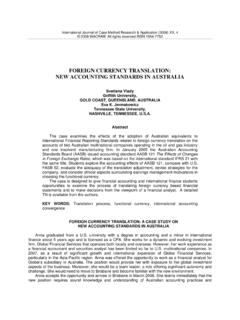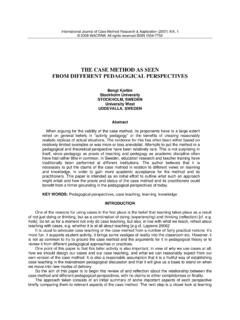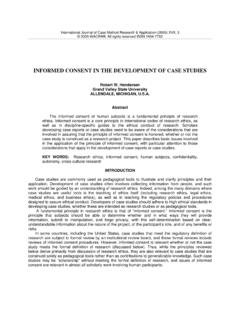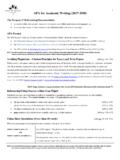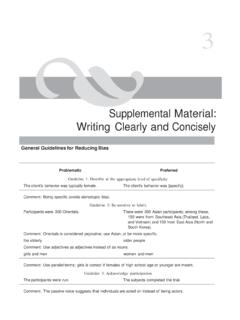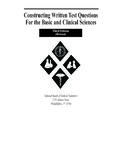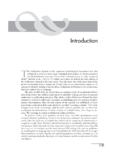Transcription of Student Written- Instructor Facilitated Case Writing
1 SWIF Learning A Guide to Student written - Instructor Facilitated case Writing by Paul Michael Swiercz, Introduction SWIF Learning Student written - Instructor Facilitated case Writing is a new learning technique designed to fully engage students in the educational experience and ease the transition from classroom to workplace. Traditional case teaching has unquestionable value, but it also has a major, if not frequently discussed, shortcoming. Traditional case methods limit the Student to the role of analyst. In this role students are primarily passive actors; as analysts they are limited to responding to facts and events as reported by someone else.
2 In contrast, SWIF Learning converts case teaching into an active learning experience. SWIF Learning requires students to assume a variety of new roles -- researcher, petitioner, interviewer, negotiator, writer, editor, team-member etc. This manual provides students with a case preparation roadmap for making the journey from passive case analyst to active case developer. We really have entered the information age and this reality, I believe, requires that the Student discard the passive role expectations of the past and assume more of the active behaviors required of practicing organizational leaders. Student written - Instructor Facilitated (SWIF) case Writing is a powerful tool for helping both students and instructors redefine their roles.
3 In the pages that follow, I provide information selected to help speed the transition and make it a bit smoother. The Manual is divided into two sections. The first section provides background information on the case Writing process and answers the most commonly asked questions about case Writing . The second section provides a guide to data resources and some tools for evaluating the case . New library technologies and computerized databases offer an extraordinarily rich array of information resources. In fact, the resources are so rich and growing so rapidly that it is impossible to summarize them in a document of this size.
4 So this second section is meant to be only a starting point; it only scratches the surface of the many resources available. The guidelines provided and the resources identified will help the new case writer prepare a clear, concise and illustrative document. Why write and study cases? Cases have played a central role in business education for decades; in fact, some schools, most notably Harvard, have built their entire curriculum around case development and use. Cases studies help us decipher, understand and use the knowledge gained through the experience of preparing them. The following is a list of seven learning benefits provided by the case Writing experience.
5 1. Integrating theory and practice case studies have the special advantage of being useful in both the generation and testing of theoretical propositions. In case study Writing , the investigator observes the working of the process under analysis and records what is happening. But simultaneously, it s the researcher s responsibility to examine the meaning of the observations and interpret them within the context of a prescribed or emergent theoretical framework. 2. Building tolerance for ambiguity and incompleteness The goal of the SWIF case study is not to find universal rules for effective management; they do not exist.
6 The objective is simpler than that; it s to help the researcher discover a personal system for probing, classifying, and interpreting unstructured data drawn from an inherently ambiguous and dynamic organizational process. 3. Developing critical thinking skills Copyright by Paul M. Swiercz. To order copies or request permission to reproduce materials call 201-994-0399 or e-mail No part of this publication may be reproduced, stored in retrieval system, used in a spreadsheet, or transmitted in any form or by any means electronic, mechanical, photocopying, recording or otherwise without permission of the copyright holder.
7 The author would like to acknowledge the professional editorial assistance provided by Greg Smith. 2 Development of case studies enables the business graduate the opportunity to think critically within their discipline of study. By "critical thinking" we mean a variety of abilities including recognizing common structures or arguments from study material, integrating across learning experiences, critically assessing an argument and being able to communicate critical ideas to others. 4. Learning to distinguish between the significant and the trivial Experienced case writers know the struggle required to ruthlessly winnow and sift to 20 pages a case story that could easily run to 50.
8 Effective authors are distinguished by their ability to recognize and tell only what is needed and leave the rest to the reader. 5. Developing Shared Learning Skills A significant discovery in the field of adult education concerns the now-known benefits of cooperative learning. Cooperative learning is distinguished by its ability to bring together students with differing learning abilities and styles into small groups where they can teach each other in a process that reinforces knowledge provided by traditional lecture and textual materials. 6. Providing an opportunity for original thought Typically, structured education teaches us to learn and repeat the outstanding thoughts of others.
9 While this is important to understanding where we've come from, it doesn't help us reach new plateaus. The Student - written case study provides an opportunity for the writer to observe a chaotic and complex experience, interpret what they see, and turn it into a disciplined and thoughtful narrative; thus, generating original thought. 7. Writing Skills Development Writing is an essential skill and objective indicator of a well-developed mind. But while students are frequently given Writing assignments, most are simple read-and-report exercises. Cases make interesting Writing assignments because they engage the writer s creative mind.
10 Cases do not come with ready-made titles and answers, and cannot be found in an encyclopedia. Well-researched and well- written cases require creativity, skill and Writing discipline all key traits of a developed writer. What is a case Study? Typically written in narrative form, a case is a distillation of real events presented so as to provide the reader with data sufficient to help evaluate alternative courses of action. According to a former Dean of the Harvard Business School, case studies are "systematically arranged problems reported from life." The best cases are those that have been created using detailed research designs accompanied by meticulous fieldwork.


